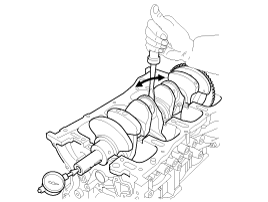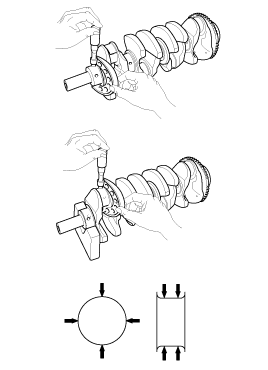Check the crankshaft bearing oil clearance.
To check main bearing-to-journal oil clearance, remove the main caps and bearing halves.
Clean each main journal and bearing half with a clean shop tower.
Place one strip of plastigage across each main journal.
Reinstall the bearings and caps, then torque the bolts.
Tightening torque
14.7 N.m (1.5 kgf.m, 10.8 lb-ft) + 27.5 ~ 31.4 N.m (2.8 ~ 3.2 kgf.m, 20.3 ~ 23.1 lb-ft) + 120 ~ 125°
Do not turn the crankshaft.
Remove the cap and bearing again, and measure the widest part of the plastigage.
Standard oil clearance :
0.020 ~ 0.038 mm (0.00079 ~ 0.00150 in.)
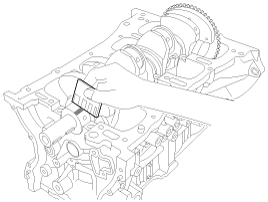
If the plastigage measures too wide or too narrow, remove the upper half of the bearing, install a new, complete bearing with the same color mark (select the color as shown in the next column), and recheck the clearance.
Do not file, shim, or scrape the bearings or the caps to adjust clearance.
If the plastigage shows the clearance is still incorrect, try the next larger or smaller bearing (the color listed above or below that one), and check clearance again.
If the proper clearance cannot be obtained by using the appropriate larger or smaller bearings, replace the crankshaft and start over.
If the marks are indecipherable because of an accumulation of dirt and dust, do not scrub them with a wire brush or scraper. Clean them only with solvent or detergent.
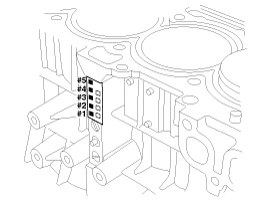
Letters have been stamped on the block as a mark for the size of each of the 5 main journal bores.
Use them, and the numbers or bar stamped on the crank (marks for main journal size), to choose the correct bearings.
Calss | Mark | Inside Diameter |
a | A | 56.000 ~ 56.006 mm (2.20472 ~ 2.20496 in.) |
b | B | 56.006 ~ 56.012 mm (2.20496 ~ 2.20519 in.) |
c | C | 56.012 ~ 56.018 mm (2.20519 ~ 2.20543 in.) |
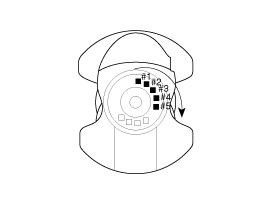
Conform to read stamping order as shown arrow direction from #1.
Class | Mark | Outside Diameter Of Journal |
I | 1 | 51.954 ~ 51.960 mm (2.04543 ~ 2.04567 in.) |
II | 2 | 51.948 ~ 51.954 mm (2.04519 ~ 2.04543 in.) |
III | 3 | 51.942 ~ 51.948 mm (2.04496 ~ 2.04519 in.) |
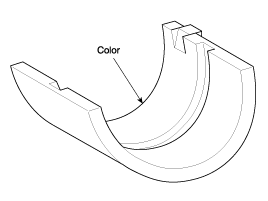
Class | Mark | Thickness Of Bearing |
AA | Blue | 2.026 ~ 2.029 mm (0.07976 ~ 0.07988 in.) |
A | Black | 2.023 ~ 2.026 mm (0.07965 ~ 0.07976 in.) |
B | None | 2.020 ~ 2.023 mm (0.07953 ~ 0.07965 in.) |
C | Green | 2.017 ~ 2.020 mm (0.07941 ~ 0.7953 in.) |
D | Yellow | 2.014 ~ 2.017 mm (0.07929 ~ 0.07941 in.) |
Crankshaft Identification Mark | Crankshaft Bore Identification Mark | Assembling Classification Of Bearing |
I (1) | a (A) | D (Yellow) |
b (B) | C (Green) | |
c (C) | B (None) | |
II (2) | a (A) | C (Green) |
b (B) | B (None) | |
c (C) | A (Black) | |
III (3) | a (A) | B (None) |
b (B) | A (Black) | |
c (C) | AA (Blue) |
